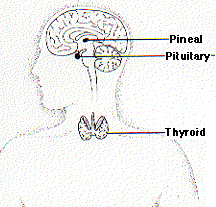










|
|

|
L-adrenaline is a hormone and a neurotransmitter. Such substances mostly transfer
short-time impulses and therefore have to be activated and inactivated very fast
and effectively. Adrenaline is synthesized in the neurones of the adrenal medulla
(see Synthesis) and stored in the chromaffin granula.
An activating signal, which can be induced through a low blood glucose level, triggers
the release of adrenaline into the blood.
|

Two enzymes are responsible for the fast and effective degradation of adrenaline:
the Catecholamine-O-methyltransferase
(COMT)
and the Monoaminoxidase
(MAO).

|
Adrenaline - a Hormone
Adrenaline has the opposite effect of insuline. It is a first messenger hormone
and will be released when the glucose level in blood is low. Because of the binding to
the  -adrenergic receptors, it triggers the adenylatcyclase
cascade (or cAMP cascade). This activating cascade effects the mobilisation of
glycogene (liver) and triacylglycerines (fat tissue) and a generel increase of the
metabolic rate. The resulting rise in blood sugar enables the fermentation of glucose
in the muscles. Adrenaline furthermore reinforces these effects, because it increases the
secretion of glucagon (a hormone with the same effects as adrenaline) and decreases
the release of insulin. -adrenergic receptors, it triggers the adenylatcyclase
cascade (or cAMP cascade). This activating cascade effects the mobilisation of
glycogene (liver) and triacylglycerines (fat tissue) and a generel increase of the
metabolic rate. The resulting rise in blood sugar enables the fermentation of glucose
in the muscles. Adrenaline furthermore reinforces these effects, because it increases the
secretion of glucagon (a hormone with the same effects as adrenaline) and decreases
the release of insulin.

|
Adrenaline - a Neurotransmitter
Adrenaline works also as neurotransmitter and has an effect on the sympathetic nervous
system (heart, lungs, blood vessels, bladder, gut and genitalia). This neurotransmitter
will be realeased by nervous stimulation in response to physical or mental stress
and binds to a special group of transmembrane proteins - the adrenergic receptors.
There are two kinds of adrenergic receptors: the  - and - and
 -receptors. -receptors.
Its effects are: increase in the rate and strength of the heartbeat, dilation of
bronchi and pupils, vasoconstriction, sweating and reduced
clotting time of the blood. Blood is shunted from the skin and viscera to the
skeletal muscles, coronary arteries, liver and brain.

|
Usage
L-adrenaline has only a short lifetime because of its fast degradation.
The oral intake of adrenaline has no effect. Therefore it has to be administered
parenterally. It is used as sympathicomimeticum (drugs, which support the beating
of the heart), broncholyticum (drugs, which relax the
brochial muscles) and antiasthmaticum (drugs against asthma).
It also is used to staunch or prevent bleedings during surgery or in the case of
inner organ bleeding. Because adrenaline leads to
contraction of blood vessels, it is administered in combination with local
anaesthetics. In this combination, anaesthetics have a longer lasting effect and can
be administered in smaller doses.
|
Last change: 1999-04-12
Frank.Oellien@chemie.uni-erlangen.de
|












